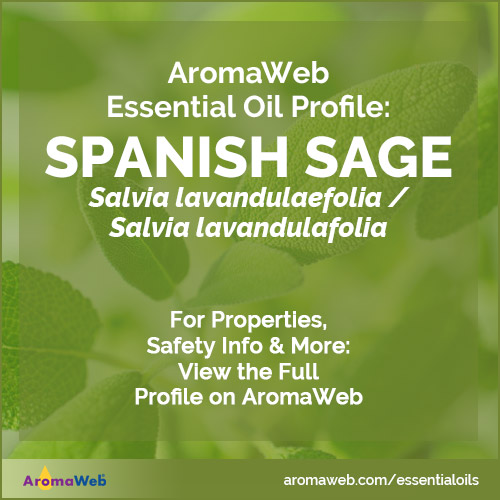Spanish Sage Essential Oil
Salvia lavandulaefolia or Salvia lavandulafolia

Description
Spanish Sage Essential Oil is also known as Lavender Sage Essential Oil.

Spanish Sage Essential Oil is a beautiful essential oil to work with for mental support and focus. Within her Alliance of International Aromatherapist Conference Presentation in 2017, Dorene Petersen discussed Spanish Sage Essential Oil as one of seven essential oils that show potential for supporting brain health (see below for more information and reference).

Spanish Sage Essential Oil contains primarily Oxides (particularly 1,8 Cineole), Ketones (particularly Camphor) and Monoterpenes. As noted below, Tisserand and Young warn that Spanish Sage Oil is an abortifacient and that it is contraindicated in pregnancy and breastfeeding.
Spanish Sage Essential Oil Benefits and Uses
- Nerve Tonic
- Headaches
- Fatigue
- Nervous Exhaustion
- Stress
- Circulation
- Arthritis
- Menstrual Pain
Source: Neryls Purchon and Lora Cantele, Complete Aromatherapy & Essential Oils Handbook for Everyday Wellness (Toronto ON: Robert Rose, 2014), 106.
- Cognitive support and brain health.
Source: Dorene Petersen, Presentation: Clinical Use of Aromatherapy for Brain Health: 7 Essential Oils. August 9, 2017, New Brunswick, NJ. Alliance of International Aromatherapists 2017 Conference. AIA 2017 Conference Proceedings page 221-222.
Botanical Name
Salvia lavandulaefolia or Salvia lavandulafolia
Plant Family
Common Method of Extraction
Steam Distilled
Plant Part Typically Used
Color
Clear
Consistency
Medium
Perfumery Note
Middle
Strength of Initial Aroma
Medium
Aromatic Description
Spanish Sage Essential Oil smells herbaceous, camphorous and possesses a subtle lavender-like characteristic.
Major Constituents
- 1,8-Cineole
- Camphor
- a-Terpinyl Acetate
- Linalool
- a-Pinene
- Camphene
- B-Pinene
See Essential Oil Safety for more complete list of typical constituents.
Source: Cordoboa Ridriguezin B.M. Lawrence, Essential Oils 1988-1991 (Wheaton: Allured Publishing, 1993), 84-86. source cited in Robert Tisserand and Rodney Young, Essential Oil Safety (Second Edition. United Kingdom: Churchill Livingstone Elsevier, 2014), 415.
Spanish Sage Essential Oil Safety Information
Tisserand and Young warn that Spanish Sage Oil is an abortifacient and that it is contraindicated in pregnancy and breastfeeding. They recommend a dermal maximum of 12.5%. Reading Tisserand and Young's full profile is recommended. [Robert Tisserand and Rodney Young, Essential Oil Safety (Second Edition. United Kingdom: Churchill Livingstone Elsevier, 2014), 415-416.]
General Safety Information
Do not take any oils internally and do not apply undiluted essential oils, absolutes, CO2s or other concentrated essences onto the skin without advanced essential oil knowledge or consultation from a qualified aromatherapy practitioner. For general dilution information, read AromaWeb's Guide to Diluting Essential Oils. If you are pregnant, epileptic, have liver damage, have cancer, or have any other medical problem, use oils only under the proper guidance of a qualified aromatherapy practitioner. Use extreme caution when using oils with children and be sure to first read the recommended dilution ratios for children. Consult a qualified aromatherapy practitioner before using oils with children, the elderly, if you have medical issues or are taking medications. Before using this or any essential oil, carefully read AromaWeb's Essential Oil Safety Information page. For in-depth information on oil safety issues, read Essential Oil Safety by Robert Tisserand and Rodney Young.
Shelf Life
Important Information About the Profiles
The essential oil information provided on AromaWeb is intended for basic educational purposes only. The references to safety information, test results, constituents and percentages is generalized information. Essential oils can vary greatly in composition. The data is not necessary complete and is not guaranteed to be accurate. The essential oil photos are intended to represent the typical and approximate color of each essential oil. However, essential oil composition and color can vary based on harvesting, distillation, age of the essential oil and other factors. Profiles for several CO2 Extracts and absolutes are included within the directory, and are denoted as such.
